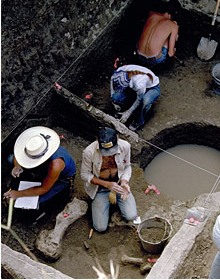resources
Teacher's Resources - Step into the Past

Archaeology is the scientific study of human cultures that predate our own, going back to ancient times. Archaeologists use excavation and analysis of artifacts, monuments and other remains to construct a picture of past civilizations. It is a constantly-changing discipline; our understanding of regional chronologies, ancient technologies and cultural interactions are constantly being refined based on the latest discoveries and interpretations. New techniques, technologies and theories also revise and further our undersatnding of ancient peoples.
The way one culture views another is highly subjective and changes over time. Subjectivity comes from many factors: one is the kind of objects that are found at a site. The first Maya artifacts discovered in 1839 in the Honduras jungle near Copán were stone monuments and temples. Many ceramics have also been found, but textiles rot quickly in the humid climate of Mesoamerica and rarely survive in any form.
Another factor is the belief system of the culture doing the investigating. As earlier archaeologists discovered monuments of the ancient Americas, they interpreted them in certain ways according to the prevailing beliefs and prejudices of their own times. In their search for artistic masterpieces to bring back to European and North American museums, they excavated grand monuments, temples and tombs, often setting aside or ignoring artifacts that they felt were unimportant.
In the present day, there is increased interest in social archaeology, or an examination of the lives of ordinary people. Museums have also changed over the last century from repositories of monuments and artifacts from so-called "vanished" civilizations, to institutions that hold their collections in trust for the benefit of their citizens, for the purpose of study and an increased understanding of human cultures throughout the world.
Classroom Activities and Projects (recommended ages are in italics and are approximate)
1. 9 -13: Create an archaeological "dig" in your classroom. You will need 2 large, shallow wooden or cardboard boxes, 70 x 40 x 20 cm., a bag of sandbox-grade sand, string, brushes, pencils and paper. The class divides into 2 groups and each takes a box. A box is filled three-quarters full with sand and each group compiles 8 -10 small objects from home or the classroom. The group creates a story of a settlement or civilization whose story can be told through these objects. After the teacher approves their objects and stories, the groups bury their objects in the sand. Then they wrap string around the boxes dividing them in 4 quadrants. The groups switch boxes. Each group must excavate each object in the box and record its position in the box on a separate chart. The objects are cleaned of sand with brushes. When all the objects are found (the other group will confirm this) then the finders must propose a story explaining the objects. Finally the two stories are compared
2. 9 -12: Take an object apart - put an object together. Students bring old, small garments from home that they are willing to donate to the class for this project. Alternately, unclaimed lost and found items can be used. Old baby and toddler clothes are ideal.
a) The class divides into 4 groups.
b) Each group, in isolation from the rest of the class, picks a garment out of the stash.
c) Record the original shape: Working in private they draw the original shape of the garment on a large piece of paper. Otherwise, once the garments are cut up no one may remember how to put them together again!
d)Add decoration: Using markers they can also add patterns and images to the garment.
e)Turn the garment into a puzzle: They carefully draw lines with marker on the garment to divide it into 6 - 8 pieces. Cut the garment (the groups should think of this in terms of creating a jigsaw puzzle).
f)Reassemble the garment: To put the mystery objects together, the groups pick the deconstructed garment of another group and reassemble it. Then they create an archaeological story starring the garment. This project can also be done with other objects. A circle of card decorated with patterns and images can be cut into a puzzle or a Styrofoam cup can be decorated and then cut up. Alternately an air-drying clay that remains flexible (like Crayola's Model Magic) can be decorated and then cut with scissors into a puzzle.
3. 9 - 13: Make a classroom chart of all the colours seen in the CLOTH & CLAY objects. This can be done with tempera paints in a series of simple shapes. In all the visual art activities the class will use these colours. Where do the colours come from? How are they made? In finding the answers to these questions students will discover much information about the cultures of the Americas. If a student wants to use another colour they must justify it by explaining where that colour would have come from (e.g. blue from blueberries - do blueberries grow there?).
4. 11 - 15: Research the career of archaeologist by investigating these questions: What do archaeologists do? What training do they need? What kinds of personal qualities and talents do you think a person would require doing archaeological work? Do they need to be physically strong? What are some careers related to archaeology/ (epigraphy, anthropology, environmental science) Would you like to have a career in archaeology?